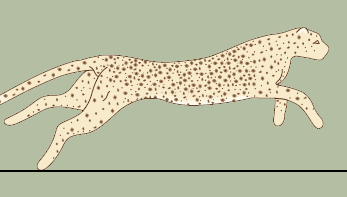3 Characteristics of the hunters
3.1 Speed and endurance
The first question in this section is a mathematical one, in which you are asked to convert from one set of units to another. If you have been following the advice in previous units in this series, you will be reading km h−1 as kilometres per hour and you will probably already think of m.p.h. as miles per hour, so the conversion should not be too difficult. You might find it helpful to look back to Table 1 in course S182_3, where the conversion of kcal g−1 to kJ g−1 was done for you. There a conversion factor was used; 1 kcal = 4.2 kJ. If you check the conversions for yourself, you find that the answers given in the second column of that table are not precisely what appears on your calculator screen. For example, for fat, the numerical part of the calculation is 9 × 4.2 which gives you an answer of 37.8, whereas the table gives 38; the answer has been 'rounded' to the nearest whole number. 37.8 is nearer to 38 than it is to 37, so in this case, the answer is rounded up. Your answers to complete Table 3 should similarly be rounded up or down to the nearest whole number.
Many people when asked to state the main specialisation of carnivores would probably suggest the speed required to catch prey. Maximum speeds can indeed be formidable, as illustrated in Table 3.
| Species | Maximum speed | Maximum speed |
|---|---|---|
| in km per hour | in miles per hour | |
| cheetah | 110 | |
| lion | 80 | |
| red fox | 70 | |
| spotted hyena | 65 | |
| jackal | 55 | |
| wolf | 45 |
SAQ 5
Question: Convert the values given in Table 3 into speeds expressed in miles per hour, rounded to the nearest whole number. (You can readily find out conversion factors from searching the web, but if this proves difficult use the value 0.6214, which converts kilometres into miles).
Answer
Multiplying 110 × 0.6214 = 68.35, which rounds down to 68. The remaining values that you should have in the completed Table 3 are: lion, 50; red fox, 43; spotted hyena, 40; jackal, 34; wolf, 28.
One of the most exciting wildlife sights is the fastest land mammal, the cheetah, at full speed; it is able to accelerate from a standing start to 96 km h−1 in just three seconds. The cheetah's slight build and long legs are the standard equipment of a fast runner, but DA draws attention to its flexible spine [p. 150] and studying the drawings in Figure 4 reveals the principle at work. Note that in frame 6 the back is arched but in 2 it is fully flexed the other way.

Activity 3
Closely observe the TV programme clip of the cheetah and its cubs (from 34.54-39.00) and make notes to enable you to answer the following questions.
(a) What features allow cheetahs to move so fast?
(b) You'll also see the cheetah stalking her prey. Why might this inconspicuous approach be an especially important feature of the cheetah's hunting strategy?
(c) What is the cheetah's response to the swerves and changes in direction made by its prey?
(Rereading LoM pp. 150-151 will be useful.)
Discussion
(a) The cheetah has long legs and a flexible spine, which enable it to straighten its back and stretch fore- and hindlimbs to a full spread (see Figure 4) and then arch the spine so that the hindlegs reach forwards in advance of the forelegs. Its strides are not only fast but long and all four limbs are off the ground [p. 151] for more than 50% of the time when running at full speed. It runs on its toes, thus increasing the effective length of the limbs and as DA points out [p. 150] the claws are non-retractable and relatively straight, acting like running spikes to grip the ground.
(b) Stalking is important to hunters that have limited endurance, such as the cheetah, where, as DA points out, sprints are seldom longer than about a minute. In the TV sequence, the gazelle escaped - only about half of cheetah pursuits end in capture; getting close undetected before the quick rush begins maximises the chances of success.
(c) Cheetahs are said to have relatively limited manoeuvrability, though on the TV evidence (at 38.02), where (in DA's words) it indeed seems 'so slim and agile that she can rival a gazelle in dodging and swerving'; the straight claws no doubt provide traction.
With the cheetah's great expenditure of energy over a short spurt, the animal's body temperature may shoot up to a dangerously high 40 °C. Gazelles seem more tolerant of increases in core temperature of this magnitude, which improves their chances of escape. But for the cheetah, a sprint of significantly more than 500 metres could prove fatal. The cheetah needs to pant rapidly - more than eight times its normal rate just to aid recovery from an intense sprint - just as a human sprinter breathes more rapidly after a race in order to take in enough oxygen to compensate for the sudden and intense expenditure of energy. The cheetah also may need up to about 20 minutes of rest to cool down. These limitations are examples of evolutionary trade-offs, where endurance is sacrificed for speed. It also seems not to have evolved the skills and weapons to defend its cubs. More than 70% of the cheetah cubs die in the lair (often killed by lions), and in the plains of Serengeti fewer than one in 20 survive to adolescence. (In fact, high infant mortality is true of many large cats.)

